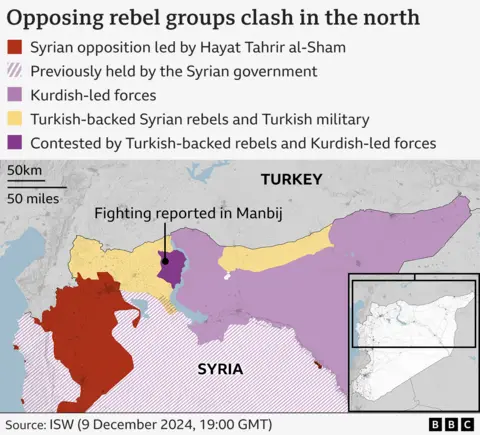 BBC
BBCIn just two weeks, Syrian rebels have swept from their enclave in the north west to capture a string of major cities, before reaching the capital Damascus and toppling President Bashar al-Assad 13 years after the start of the country’s civil war.
In convoys of small vehicles and motorbikes, fighters led by the rebel group Hayat Tahrir al-Sham (HTS) moved rapidly along the north-south highway which forms the country’s main spine to take Damascus without resistance.
But while many in the country are celebrating the downfall of a family dynasty that ruled Syria with an iron fist, the future is uncertain and the situation on the ground remains in flux, with a number of different rebel groups controlling different parts of the country.
Who controls what territory in Syria?

The fall of the Assad regime was brought about by the sudden and unexpected advance by HTS rebels but, although the group controls Syria’s main cities, it does not govern the whole country.
Syria has for years been controlled by a patchwork of rebel groups including HTS in Idlib and Kurdish-led groups in the country’s north east, some of which have also taken territory in recent days and weeks.
None of the rebel groups will mourn the falling of the Assad regime, but finding a consensus over how to run the country could still prove difficult and in the north of the country there have been clashes between competing factions.
How did the rebels reach Damascus?
After years locked behind frozen frontlines, the rebels mounted a lightning advance, culminating in the toppling of the president and takeover of the capital at the weekend.
After taking Syria’s second city Aleppo at the end of November, the rebels continued their offensive, moving south to take control of the city of Hama last Thursday.
The advance continued at pace, with Syria’s third city, Homs, falling on Saturday shortly before government forces also lost control of the capital.

Map: Where is Syria and how are its neighbours involved?
Syria, with a population of about 22 million people, is located on the east coast of the Mediterranean sea. It borders Turkey to the north, Lebanon and Israel to the west and south west, Iraq to the east and Jordan to the south.
Turkey, Western powers and several Gulf Arab states have backed varying elements of the Syrian opposition to varying degrees during the conflict.
The Lebanon-based Hezbollah movement, backed by Iran, has fought alongside the Syrian regime army but has been severely weakened by its conflict with Israel. This has been seen as a key reason why the rebel advance was so successful.
Israel, concerned by what it calls Iran’s “military entrenchment” in Syria, has launched air strikes against Syria’s military.

How has Israel responded?
Israeli warplanes have reportedly been carrying out hundreds of airstrikes across Syria, targeting Syrian Army military facilities, including weapon warehouses, ammunition depots, airports, naval bases and research centres.
The UK-based Syrian Observatory for Human Rights (SOHR) says it has documented more than 300 strikes by Israel since the fall of the Assad regime on Sunday, including on the capital, Damascus, Aleppo and Hama.
Reports say that many of the facilities hit have been completely destroyed.
Israel says its actions are to prevent weapons falling “into the hands of extremists” as Syria transitions into a post-Assad era.

Israel also says it has temporarily seized control of a demilitarized buffer zone in the Golan Heights, saying the 1974 disengagement agreement with Syria had “collapsed” with the rebel takeover of the country.
It denies reports it has tanks approaching Damascus but says some troops are operating in Syrian territory beyond the buffer zone.
The Golan Heights is a rocky plateau about 60km (40 miles) south-west of Damascus.
Israel seized the territory from Syria in the closing stages of the 1967 Six-Day War and unilaterally annexed it in 1981. The move was not recognised internationally, although the US did so unilaterally in 2019.

What is happening in northern Syria?
In the northern city of Manbij there have been clashes between Turkish-backed forces and Kurdish-led rebels.
Both sides claimed to have taken parts of the city and fighting is reported to be ongoing in some neighbourhoods.
Analysts at the Institute for the Study of War said they could not yet ascertain who was in control of Manbij.

Russian bases in Syria
In 2015, Russia sent thousands of troops to Syria to help keep President Assad in power.
In return for this military assistance, Russia was given 49-year leases on two key military bases.

The port at Tartous is Russia’s only major overseas naval base and also its only naval base in the Mediterranean.
Along with the air base at Hmeimim, which is often used to fly Russia’s military contractors in and out of Africa, the two bases play an important role in Russia’s ability to operate as a global power.
The Kremlin has said it will hold discussions with Syria’s new administration on the future of both sites.
 Getty Images
Getty Images



